Modern domestic non-nuclear submarines
The naval submarine of the 877 project was planned by the Soviet Navy for mass serial construction (more than 80 units) and export deliveries. In this regard, along with the high requirements for the combat qualities of the new NNS, there were also demands to simplify the construction and operation of the submarines. This has largely shaped the look of the 877 project, and with its strengths and weaknesses.
In the early to mid-70-ies in the Soviet Navy, the fight against enemy submarines went to the first place in the priority tasks of naval submarines, primarily to ensure the deployment of nuclear submarines and cover SSBN patrol areas. For this reason, the 877 project imposed strict requirements to ensure a very low level of physical fields (and in some cases using already mastered equipment and tools of the previous generation, which made it difficult to fulfill these requirements).
This task was brilliantly solved by the developer - Rubin Central Design Bureau and Chief Designer of the 877 project Yu.N. Kormilitsyn. Another solution, which largely determined the appearance of the entire project, was the use of Rubikon GAK-400 GCS with large-sized nasal antenna noise-finding. It can be said that the naval submarine was designed “around” the SAC and its main antenna. For the analog complex, the Rubicon had a high detection potential, was performed at a very good technical level for the beginning of 70, and ensured a significant advance in the detection of the submarines of our 80 submarines in 877. However, there was also a “flip side”. It should be noted that along with Rubikon SJSC, at the end of 60x, other SACs were also developed, including having developed onboard detection antennas. However, it was Rubicon that was developed for serial production and was developed as a unified GAK for naval submarines and nuclear submarines of a number of projects (670M, 667BDR, 675M, and others).
From today's position, this unification was a mistake. The main reason for the rejection of the use of developed on-board antennas for most domestic atomic submarines was a high level of interference - a problem that was largely resolved only at the 3 generation of atomic submarines.
Therefore, the main direction in the development of antennas SJSC HLK PL has become the implementation of the largest large nose antenna of direction finding (which had the least level of interference), therefore, the onboard and towed antennas (which played a very important role on the western PL) were practically not used.
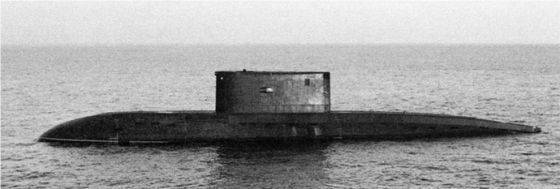
Source: http://arsenal-otechestva.ru/
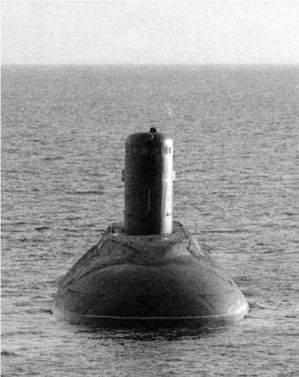
Source: http://arsenal-otechestva.ru/
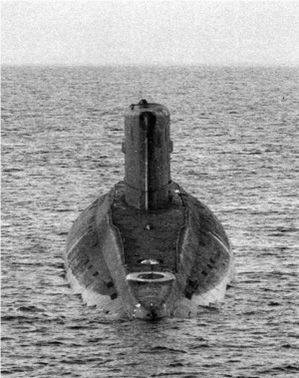
Source: http://arsenal-otechestva.ru/
The large dimensions of the antenna of the Rubikon GC largely determined the size and displacement of the submarines of the 877 project. At the same time, the displacement of the new NNS turned out to be close to the submarine of the 641 project, which had a much larger ammunition and the number of torpedo tubes (TA). Their reduction should have been compensated for the TA fast-loading device and the torpedo telecontrol complex, and the installation of the small-sized KUU MVN-110 Knot would increase the success of the torpedo attacks. The composition of the ammunition included remote-controlled electric anti-submarine torpedoes TEST-71М, oxygen anti-ship 53-65К, with ensuring the reception of all previous types of torpedoes (except peroxide) - 53-56В, СЭТ-53М, СТ-65 (X-NNXX, SET-60М, СЭТ-74), and, in connection with the plans, in order to apply the post-test requirements. hydroacoustic countermeasure devices (GPA) MG-53 caliber 80cm. Planned promising torpedo USET-XNUMX with mechanical data entry and body control.
For statement of means of GPD - devices GPD MG-34 and GIP-1, two VIPS devices were used.
The 877 project had a “standard set” of communications, radar, radio and radio intelligence. However, it seems unreasonable "savings" - the refusal to install a satellite navigation system. Acting in various regions of the World Ocean, in a number of cases our NNS had significant errors in determining the location, and not so much because of the navigators' errors, but for objective reasons that it was impossible to determine the exact location of the available means in actual conditions. The problem existed and significantly influenced the effectiveness of the actions of the naval forces in both remote and some "near" areas of the sea.
In addition, one of the serious shortcomings of communications and control of naval submarines of the Navy of the USSR was the lack of regular means of transmitting information from the depth in the KW range. Used with VIPS buoys MRB had only VHF range and a limited range of communication.
In assessing the combat capabilities of the naval submarines of the 877 project, at the time of creation, it should be noted:
The very low noise and the large potential of the analog SJC Rubicon ensured a pre-emption in detecting the submarines of a “probable enemy” in most tactical situations.
The big drawback of Rubikon was the lack of on-board antennas (and the possibility of generating a distance to targets in the passive mode without performing special maneuvering) and the absence of a flexible long antenna (GPBA). The latter is probably related to the large dimensions of the sampling device (OLA) of such antennas, which made it difficult to use them on the submarine. Go for a solution implemented on many Western naval installations - the permanent attachment of the GPBA with a “clip” before going to sea (that is, without UPV) was not enough for the Navy. At the same time, the presence of the GBPA is extremely important for NNS (diesel-electric submarines), especially for ensuring the safety of NNBL when charging batteries, when, due to high levels of interference, the effectiveness of conventional HAC decreases sharply.
The MGA-519 “Arfa-M” excellent MAS mine detection (GAS MI) not only provided a high-quality solution to this problem, but also was a great help in ensuring navigation navigation safety, increasing the capabilities of 877 submarines in combat with enemy submarines or surface ships (NK) of the enemy (due to the confident classification of the GPA facilities, the possibility of telecontrol according to the high-precision and interference-free GAS MI). When performing torpedo firing, the Harp successfully “saw” even torpedoes.
Having preemption in detecting enemy submarines (and, accordingly, weapons) The 877 project had simple and reliable TEST-71М torpedoes in ammunition, but their capabilities were significantly limited by the outdated telecontrol system (which provided the TU of only one torpedo in the salvo, and only managed it in a horizontal plane).
The “anti-ship capabilities” of the NNS were determined by the number of TAs in which the autonomous torpedoes 53-65К were located, the capabilities of the fast-loading device for reloading the TA and TTX of the torpedo 53-65К. It should be emphasized that high reliability and absolute stability to the GPA means of homing (CCH) on the wake trail of the 53-65K torpedoes at the same time limited its effective salvo distances (less than 9 km with a full range of 19 km). For a significant increase in salvo distances, a telecontrol system was needed, but the initiative of the torpedo developer to introduce a telecontrol system on it (in the middle of 80) did not arouse the interest of the Navy. As a result, in terms of the “anti-ship potential” of the 877, the project was noticeably inferior to the previous submarines of the 641 project (which had more TA, and the same torpedoes).
The means of protection (counteraction) of the NPSL of project 877 were initially insufficient, and this was one of the most serious shortcomings of Project 877. The developer (Rubin Design Bureau) could not influence this situation during the design process - the requirements and nomenclature of these funds were determined by the Navy, and The leading organization for underwater weapon systems and counteraction was the Malachite Special Design Bureau. This may also include the absence in the ammunition submarine of the Navy of the USSR of means for suppressing radio lines "radio sonar buoy - aircraft", despite the extreme danger to the Navy from anti-submarine aviation enemy. The effectiveness of the MG-34M and GIP-1 (put into service in 1968) was already low in the 80s. The MG-74 self-propelled device had a number of disadvantages, and most importantly, it required the abandonment of part of the ammunition (which had already decreased from the 641 project). However, measures to resolve this situation were not taken by the Navy, despite a number of excellent developments - both in industry and fleets (one of the examples of the latter is the GPD onboard complex developed and manufactured on an initiative basis and installed on board the S-37 submarine of the Black Sea Fleet (commander, Captain 2nd Rank Proskurin). During numerous exercises, the S-37 received the nickname "invisible" and was a single torpedo (all were diverted by the onboard GPE complex).
Substantial displacement of the 877 project's submarines substantially limited the possibility of its use in shallow areas, therefore the Soviet Navy used them mainly in oceanic areas and areas with great depths.
The constructive simplicity and accessibility of the 877 naval submarines of the project ensured a quick and high-quality mastering by their crews, and a full disclosure of their capabilities in the process of application.
In 1985, export shipments of 877 naval submarines for the Indian Navy (and several other countries) began. It is interesting to compare the “direct competitors” - our naval submarines of the 877ECM project, and the naval submarines of the German 209 / 1500 project in the Indian Navy. "Varshavyanka" demonstrated a high secrecy and significant advancement in the detection of "German". In the book “Whale Jump” (about the creation of the “Knot” CIU), evidence of an eyewitness — representative of the service team S. V. Kolon — is given: “... was a witness to the return of the Sindhugosh submarine from a hike in which the training X. I think of the project, just to assess their capabilities. It was in the waters of the Arabian Sea. Our lieutenant, a Hindu servicing “Knot”, who was behind the commander’s console, after this battle in joyful excitement, said to me with glitter in his eyes: “They didn’t even notice us and were sunk”
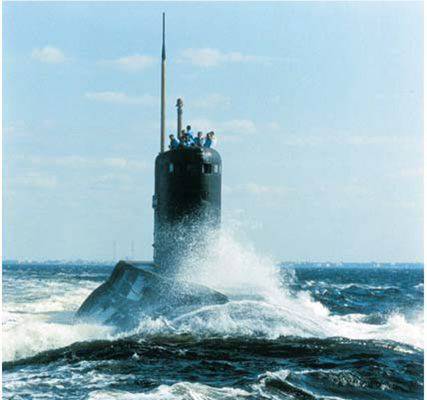
Source: http://arsenal-otechestva.ru/
When comparing the complexes of weapons of our NPS and German, it is necessary to note the large effective firing distances of the “Germans”, a consequence of the significantly more advanced remote control system of western torpedoes, which, however, with the available means of detection and targeting in real conditions of the Arabian Sea could not be realized. At the same time, the high reliability and simplicity of the weapon and the submarine of the 877ECM project ensured their rapid mastery by the crews and their application at the “maximum of capabilities”.
877 project development
During the construction of a series of naval submarines of the 877 project, the developer made a serious modernization of the project, which in its “summary” resulted in a deep modernization of the 877 project - the 636 project. The main areas of modernization were:
a further increase in the stealth of naval submarines (by reducing the levels of underwater noise (SSH)),
breaches of stealth ”(ratios of battery charging time to time spent at sea), and in the future - the introduction of lithium-polymer batteries of increased capacity;
improvement of radio electronic equipment (RES);
improvement of weapons and countermeasures.
The deep modernization of SJC Rubicon, performed on a very high-quality and modern technical level, became the core of the modernization of the RES. At the same time, the SJC MGK-400EM is a “basic solution” that ensures the implementation of a wide range of SAC PL (from the “minimum”, “GAS MG-10М dimensions” - the MGK-400EM-01 to 400 atomic submarine "Chakra", and modifications of MGC-03EM for NNL with GPBA).
However, it is necessary to note the shortcomings “inherited” from the constructive of the old SJC Rubicon:
limited sector of the sonar subsystem;
lack of airborne antennas (range determination mode in passive mode)
the unjustified limitation of the scale of the excellent modernized GAS MI “Arfa” (in fact, it “sees” much further;
low accuracy of the OGS subsystem in the range of the SSN torpedoes (definition of only the quadrant sector).
At the same time, it is necessary to emphasize once again the worthy technical level of the SJC MGC-400EM (including the GPBA subsystem), highly appreciated by customers, when working with low-noise targets in difficult conditions. The above disadvantages can and should be eliminated in a short time during the modernization of the SSC, - with the provision of a sharp increase in the combat capabilities of the SAC and submarines.
In addition to the GAK, in the course of the modernization of the 636 project, a modern radar complex (RLC), new radio and electronic reconnaissance, communications and control systems (Lama CMS) and a periscope complex were installed. For the upgraded Indian NNS of the 877EKM project, RESs of Indian and Western production (including GAK and GPBA) were introduced.
The key element of the modernization of the 636 weapons complex was the introduction of the CLAB missile weapons complex with the 3М14E CR and the 3М54 ЭХNUMX CRP. The people who created CLAB made an almost feat - under the most difficult conditions of 1, managing to “break through” the project through a lot of bureaucratic barriers and implement it. Given the problems with torpedo weapons, this practically saved our submarine shipbuilding in the 90-early 90-x.
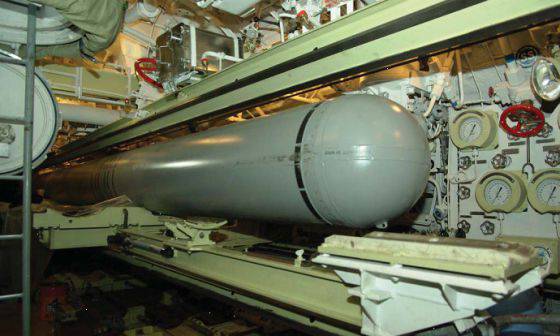
Source: http://arsenal-otechestva.ru/
After the collapse of the USSR, there was a crisis situation with the release of torpedoes for export submarines of the 877EKM project. The 53-65KE torpedo was produced by the Mashinostroitelny Plant. Kirov, Alma-Ata, Kazakhstan. Torpedo TEST-71МЭ had an imported (Ukrainian) battery, and most importantly it was purely anti-submarine. An attempt by the Dvigatel plant to create a universal torpedo at its base (with the installation of a SSN on the wake) was unsuccessful due to the obviously insufficient TTX. Therefore, for the implementation of the Chinese contract, an export modification of a USET-80 torpedo with mechanical data entry was created - a remote-controlled torpedo UETT. Subsequently, WETT became TE2 (a localized version for the Dvigatel plant). At the same time, the development of a UGST remote-controlled torpedo with power installation on unitary fuel, which had high performance characteristics and perfect CLO, was carried out.
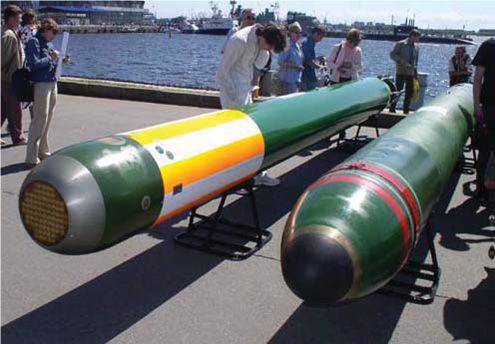
Source: http://arsenal-otechestva.ru/
However, the state of torpedo weapons is one of the main problems of domestic naval submarines, primarily due to the shortcomings of the national TU system.
As noted above, the drawbacks of countermeasures (MG-74, MG-34M, GUI-1) were one of the most serious shortcomings of the 877 project. In 2004 to replace the drifting device MG-34М CJSC Aquamarine, an excellent, for that time, drifting device of anti-torpedo protection Vist-E was developed.
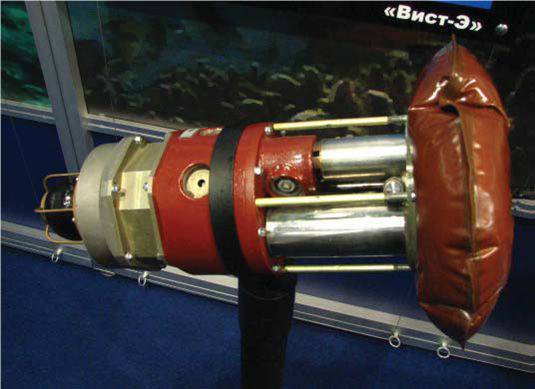
Source: http://arsenal-otechestva.ru/
In the middle of the 2000x, a serious modernization of the MG-74 self-propelled device was carried out, - in fact, the development of a new MG-74М device, made at a modern level. The self-propelled device MG-74M was developed in versions with mechanical and electronic data entry.
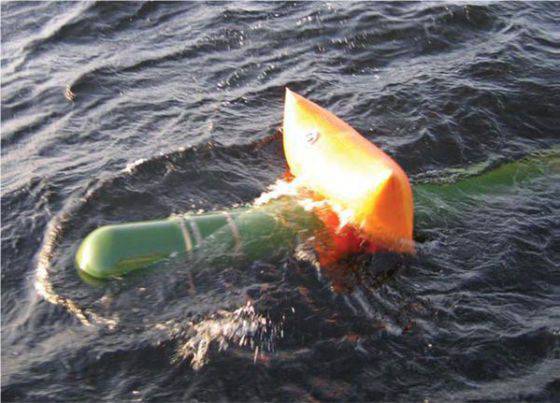
Source: http://arsenal-otechestva.ru/
However, by this time some foreign customers began to focus on other means of counteraction, in particular - the WASS C-303S complex.
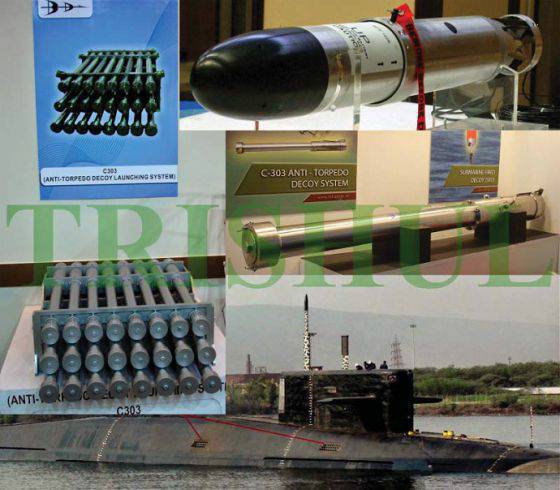
Source: http://arsenal-otechestva.ru/
In evaluating these GPA tools, both the C-303S complex and Vist-E, their limited effectiveness against the latest torpedoes should be noted.
The transition to ultra-wideband SSN torpedoes sharply reduced the effectiveness of existing countermeasures (including C-303 systems), raising the question of the possibility in principle of effectively counteracting such SSN by means of GPA.
The answer was active countermeasures (anti-torpedoes) and the development of a new generation of anti-torpedo defense (PTZ), the main features of which were:
ensuring massive use in minimal time;
a sharp increase in the energy potential of broadband interference;
high sensitivity and adaptability to the noise-signal environment.
The implementation of the new requirements for the SGDS means of the complex C-303S can not be performed due to the small mass-dimensional characteristics of these funds. Obviously, a transition to an increased caliber is needed (approximately 200-220mm) in order to increase the power of the instruments and to realize adaptability to the noise-signal environment.
At the moment, the development of such CRPDs has not been completed in any country; today in a submarine war the “means of attack” (CLS torpedoes) are clearly ahead of the “means of protection” (SGPD PTZ). In these conditions, anti-torpedoes will have a very large role.
NNS of the 677 project (Amur project).
As already noted above, the main factor influencing the appearance of the 877 project's submarines was the size of the main antenna of Rubikon. At the same time, large numbers of naval submarines of the average displacement of 613 projects were in large numbers in the USSR Navy, and its development was an exceptionally successful 633 project. The problems of the USSR national hydroacoustics in 70x excluded the creation of an effective subwoofer of average displacement to replace 613 and 633 projects, precisely because of the absence of a compact HOOK with high search potential. The required scientific and technical reserve was obtained only at the end of the 80s, and the creation of the naval submarines of the average displacement of the 677 (Amur) project was in the most difficult years for our defense industry and shipbuilding.
The submarine of the 677 project was first introduced at IMMS-2005, but its fine-tuning has been delayed for many years.
A description of all the twists and turns of 677 is not the topic of this article (especially since there is a lot to be able to write about soon), however, according to the author, the key problem of implementing this project in 1990-2000-ies was haste and unfounded hopes for New design technologies ”without their testing and complete testing in bench conditions. As a result, all the existing problems were “tucked into a solid hull”, and they had to be solved literally through the “narrow neck of the log hatch”. Probably, if the customer did not hurry so much with the terms (for example, they would reasonably have moved them at the beginning of 2000's to 3 – 4 of the year), the naval submarines of the 677 project in the Navy would have already gone into combat service and exported.
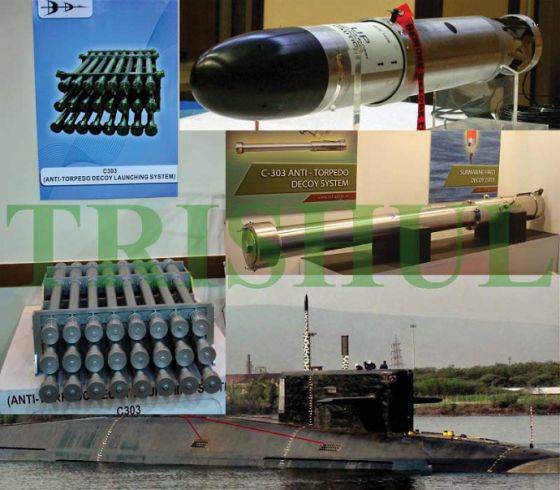
Source: http://arsenal-otechestva.ru/
The lesson was cruel, but the conclusions from it were made. Today, when the serial construction of the 677 submarines of the project has been resumed, the question arises in the society - will not the “edinichki” under construction of this project repeat the fate of the head submarine? It is safe to say that this will not happen. From past mistakes not only conclusions were made, but measures ensuring the successful implementation of the project were developed, implemented and actually work. An example of this is the successful implementation of the Rubin Central Design Bureau of the most complicated project to create the Bulava maritime strategic system.
With high probability, it is possible to predict the successful implementation of the project to create a promising anaerobic power plant for subs.
The main features of the naval submarine project 677 ("Cupid"):
modern SAC with high search potential and new RES;
low-noise diesel-electric main power plant with a valve engine (with installation of an anaerobic plant);
extremely low noise level and a new anti-roll coating;
single body design;
reduced in comparison with NNS
project 636 displacement, facilitating actions in areas with shallow depths.
The range of export versions 677 - "Amur" provides for a number of modifications, including an extremely index and promising project “Amur-950” with the installation of a vertical start-up (UVP) on the 10 KR (RCC), which ensures the application of a powerful simultaneous rocket attack.
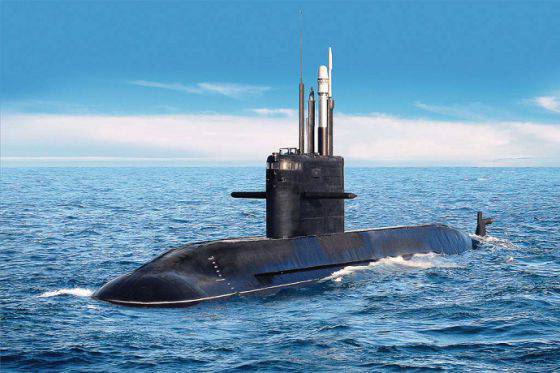
Source: http://arsenal-otechestva.ru/
Today it is difficult to predict how many “Cupids” will be built, and whether the success of the 877-636 project with more than fifty submarines will be repeated. However, the fact that the project 677 ("Cupid") will be successfully implemented - no doubt.
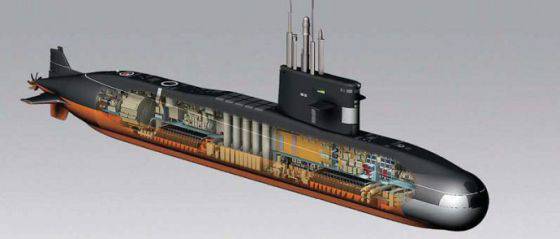
The main issue here is the feasibility of building "classic naval submarines" (diesel-electric), taking into account the widespread in the world of naval submarines with anaerobic facilities and the development of anti-submarine defense (ASW). When considering this problem, three issues are most important.
The first. The use of an anaerobic plant really provides a sharp increase in the stealth of the naval subsystems primarily by the criterion of the “coefficient of stealth violation”), however, it provides only small strokes of the naval subsystems and dramatically increases the cost and complexity of operating the naval subsystems, significantly reducing its autonomy.
It is important - several variants of such a power plant for domestic naval submarines are already “on the way”.
Second. The emergence of modern lithium-polymer batteries dramatically increases the underwater autonomy of diesel-electric submarines, being at the same time a much more economical solution than an anaerobic GEM.
Third. The general state of the problem of confrontation "submarine against the aircraft." The sharp increase in the capabilities of anti-submarine aircraft to detect low-noise targets in recent decades has raised the question of the survival of submarines in the context of its countermeasures. And by itself, the presence of an anaerobic installation of an anaerobic installation does not ensure its safety, for example, with the anti-ship missile salvo from the submarine. Unmasking a naval missile with a PKR salvo (KR) while staying in the area of anti-submarine aviation with modern means of search puts any naval submarine on the brink of destruction. In fact, there is a situation when the combat stability of naval submarines in such conditions cannot be ensured solely due to its secrecy, an integrated approach is necessary, including active countermeasures of aviation (ZRK PL), low-frequency means of GPA, ensuring the suppression of the RGAB in the "underwater hemisphere" and means of jamming the communication lines "buoy-plane" in the "above-water".
It is necessary to emphasize that today such facilities (with the required level of efficiency) are not found in any foreign naval base. The effectiveness of IDAS submarines IDAS (Germany) and A3SM (France), is obviously insufficient, and it can not provide effective protection of the naval submarines. Without going into details, it should be noted that Russia has the necessary groundwork and the scientific and technical potential for creating such NNLs with a high (necessary) level of efficiency.
It is important to note that the presence of an effective air defense missile system is probably a more effective and simple solution for naval submarines than an anaerobic plant (provided that lithium-polymer ABs are used), but also provides the ability to effectively “incorporate” naval submarines into the operational-tactical network of on the theater of operations, increasing both its effectiveness and the effectiveness and combat stability of the most naval submarines (due to the sharp improvement in situational awareness and the possibility of operational communication with the command). This undoubtedly puts additional (but real!) Requirements for onboard communications and combat control on board a naval base.
636 "plus" and "Cupid plus"
Despite the fact that today the 636 and Amur projects look decent against the background of their competitors, their development and modernization in the direction of:
the implementation of a weapon complex as a high-precision torpedo weapon complex (WTCP) similarly to Western naval submarines
the inclusion in the ammunition of such a highly effective means of PLO as anti-submarine missiles (PLR);
implementation of an effective self-defense and counteraction complex, including anti-torpedoes, modern means of GPA (anti-torpedo protection and suppression of HAS and RGAB) with outboard multi-barrel launchers of 210mm caliber, EW radio line "buoy-plane";
creation of an effective air defense missile system;
introduction of lithium-polymer AB and anaerobic power plants;
improvement of the submarine NNS, especially against sonar facilities (rejection of “direct” “glaring” fencing of sliding devices, use of modern anti-hydrolocation coatings on the 636 project);
development of communication and control means ensuring the effective implementation of the concept of the All-Territorial Training Organization and the “inclusion” of submarines in the network-centric communication and control system in the theater of operations
It is interesting to question the feasibility of the development of the 636 project after the deployment of the serial construction of the naval submarines of the 677 project (Amur).
I think that the customer should be the first to solve this issue. Despite the more recent development of Amur and a smaller displacement, the 636 project still has significant development prospects:
A large number of naval submarines of the 877ECM and 636 project in the naval forces of foreign countries (and the Russian Navy) set the task of upgrading them (up to creating a promising version of the 636 project, using new complexes and systems (including with the Amur submarines) );
the double-hulled design ensures the reception of an enhanced fuel reserve (in the Central State Library) and a significant increase in the cruising range, while the large-displacement submarines with a large radius and duration of patrols constitute a very significant segment of the submarine market;
the introduction of multi-barreled outboard launchers dramatically increases the combat capabilities of naval submarines, and the 636 project has for this significant amounts of lightweight body and superstructure.
From the point of view of improving the combat qualities of naval submarines, it is obviously necessary:
Comprehensive modernization of torpedo weapons NNL, GAK and BIUS to ensure maximum effectiveness of torpedoes for long distances (introduction of fiber optic telecontrol, smooth change of the travel mode (and a number of other solutions), introduction of on-board antennas to the GAK with the implementation of passive distance determination by targets and ensuring coordinated processing of information of various antennas GAK PL and transmitted from the board of torpedoes). This modernization should be carried out not only in relation to new models, but also old ones, first of all torpedoes TEST-71МЭ, in a significant number of 877EKM project ammunition submarines.
Introduction to ammunition NNL PLR, as a means of ensuring the defeat of enemy submarines in the shortest possible time. This requires expanding the capabilities of the SAC sonar subsystem.
Equipment of naval aircraft with new means of counteraction (air defense system, GPA, electronic warfare "bui-plane", anti-torpedoes.
On the issue of the use of anti-torpedo, it is necessary to dwell on. Russia has a significant priority in creating active means of anti-torpedo protection, and today the anti-torpedo of the Package-E / NK complex provides the greatest likelihood of attacking a torpedo among its competitors. The implementation of the anti-torpedo (AT) complex “Package-E / NK” on the naval submarines of the 636 and Amur projects sharply increases the effectiveness of their anti-torpedo protection and export potential.
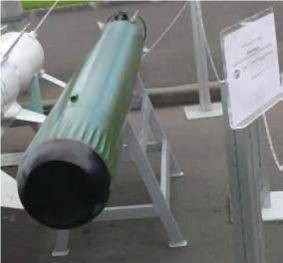
[center] Antitorpeda (AT) of the “Package-E / NK” complex
Source: http://arsenal-otechestva.ru/
[/ Center]
It should be understood that the installation of anti-torpedo requires the use of special high-precision means of targeting. The use of a full-time GAS TSU complex "Package-E / NK" is impractical because of the limited sector of the review. To ensure the effective use of airplanes and airborne submarines, a special HAC of the control center with the most “spherical” viewing area, similar to the GUS with a spherical antenna developed by Okepribor OJSC under the Echo Search topic, is necessary.
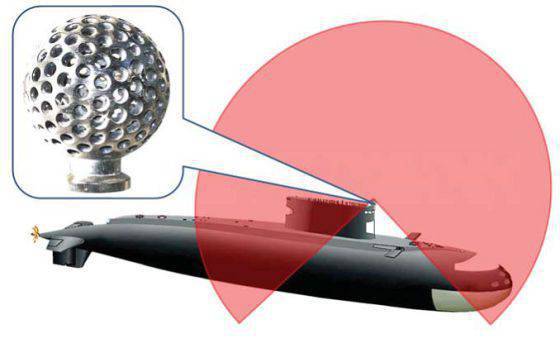
Source: http://arsenal-otechestva.ru/
Equipping naval submarines of the 636 and Amur project with anti-torpedoes dramatically increases their export attractiveness, and carrying out a comprehensive modernization will increase the combat potential many times and ensure that prospective requirements for the naval submarines are met while ensuring superiority over foreign naval submarines.
Information